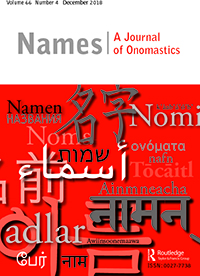“My Name is A-on-the-cheek”: Managing Names and Name Signs in American Sign Language-English Team Interpretation
Published 2018-10-02
Keywords
- family names dictionaries,
- dictionary writing systems,
- lexicographic processing of large data,
- born-digital dictionaries,
- family names etymology
Copyright (c) 2018 American Name Society

This work is licensed under a Creative Commons Attribution 4.0 International License.
Abstract
Interpreters face challenges when rendering names between languages. First, names may be unknown to the interpreter or contain culturally specific information. Further, names lack contextual clues that aid the decoding process. Finally, names may be pronounced in a manner that is difficult to understand (e.g., rapidly or with an accent). Spoken language interpreters have the option of repeating names in their original form; however, signed language interpreters work between languages produced in distinct language modalities (sign-speech) that share no phonological features; thus, names cannot simply be reproduced across languages. In this study we created a mock scenario between two interlocutors (a hearing computer specialist and a deaf international student) who enacted a training session in which they deliberately incorporated names. The interlocutors repeated this training session three times, each with a different team of interpreters. We report strategies used by the teams to convey names in their interpretations.
References
- Audissino, Eminio, 2012. Italian doppiaggio. Dubbing in Italy: Some notes and (In)famous examples. Italian Americana 30(1): 22–32.
- Brøndsted, Katrine, and Cay Dollerup. 2004. The names in Harry Potter. Perspectives: Studies in Translatology 12(1): 56–72.
- Carlet, Laura. 1998. G.V. Chernov’s psycholinguistic model in simultaneous interpretation: An experimental contribution. The Interpreter’s Newsletter 8: 75–92.
- Chernov, Ghelly V. 2004. Inference and anticipation in simultaneous interpreting: A probability-prediction model. Amsterdam: John Benjamins.
- Conte, Serena, Alessio Di Renzo, Giulia Petitta, Paolo Rossini, and Virginia Volterra. 2013. Sign language toponymy in Italy: Synchronic and diachronic variation. Paper presented at the Trends in Toponymy 6 Conference, Oct. 7–10, Heidelberg, Germany.
- Dean, Robyn K. 2014. Condemned to repetition? An analysis of problem-setting and problem-solving in sign language interpreting ethics. Translation & Interpreting 6(1): 60–75.
- Di Renzo, Alessio, Serena Conte, and Giulia Petitta. 2015. Deaf communities through the name signs lens: Language, community, identity. Paper presented at the First Worldwide Congress for Language Rights, May 19–23, Teramo, Italy.
- Gile, Daniel. 1984. Les noms propres en interprétation simultanée. Mutlilingua 3 (2): 79–85.
- Gile, Daniel. 1995. Basic concepts and models for translator and interpreter training. Amsterdam: John Benjamins.
- Hoza, Jack. 2010. Team interpreting as collaboration and interdependence. Alexandria, VA: RID Press.
- Jordan, Peter. 2012. Place names as ingredients of space-related identity. Oslo Studies in Language 4 (2): 117–131.
- Lamberger-Felber, Heike. 2001. Text-oriented research into interpreting. Examples from a case study. Journal of Linguistics 26: 39–64.
- Matthews, Phillip W., Rachel L. McKee, and David McKee. 2009. Signed languages, linguistic rights and the standardization of geographical names. In Names in multi-lingual, multi-cultural and multi-ethnic contact. Proceedings of the 23rd International Congress of Onomastic Sciences, Eds. Wolfgang Ahrens, Sheila Embleton, and André Lapierre, 721–732. Toronto: York University.
- McKee, Rachel, and David McKee. 2000. Name signs and identity in New Zealand Sign Language. In Bilingualism and identity in deaf communities. Ed. Melanie Metzger, 3–40. Washington, DC: Gallaudet University Press.
- Meadow, Kathryn P. 1977. Name signs as identity symbols in the deaf community. Sign Language Studies 16(1): 237–246.
- Nicodemus, Brenda, Laurie Swabey, Lorraine Leeson, Jemina Napier, Giulia Petitta, and Marty Taylor. 2017. A cross-linguistic analysis of fingerspelling production by sign language interpreters. Sign Language Studies 17(2): 143–171.
- Nonaka, Angela, Kate Mesh, and Keiko Sagara. 2015. Signed names in Japanese Sign Language: Linguistic and cultural analyses. Sign Language Studies 16(1): 57–85.
- Paales, Liina. (2011). Name signs for hearing people. Folklore: Electronic Journal of Folklore 47: 43–76.
- Peruzzi, Anna-Maria, Paolo Rossini, Tomasso Russo, and Virginia Volterra. 2000. Segni nome ed identità personale nella LIS. In Viaggio nella città invisibile. Atti del II Convegno nazionale sulla LIS. Eds. Caterina Bagnara, Giampaolo Chiappini, Maria Pia Conte, and Michela Ott, 488–494. Pisa, Italy: Edizioni del Cerro.
- Petitta, Giulia, Mark Halley, and Brenda Nicodemus. 2016. Managing metalinguistic references in bimodal interpreted discourse: An analysis of an American Sign Language-English interpretation. Rivista di Psicolinguistica Applicata 16(2): 53–69.
- Petitta, Giulia, Mark Halley, and Brenda Nicodemus. 2018.‘What’s the sign for nitty gritty?’ Managing metalinguistic references in ASL-English dialogue interpreting. Translation and Interpreting Studies 13(1): 50–72.
- Reck Anne-Kathrin. 2009. Pointy helmets and buck teeth: Naming in sign language – An exploration. In Names in multi-lingual, multi-cultural and multi-ethnic contact. Proceedings of the 23rd International Congress of Onomastic Sciences. Eds. Wolfgang Ahrens, Sheila Embleton, and André Lapierre, 828–836. Toronto: York University.
- Revilla, Bettina. 2009. Place names in Israeli Sign Language. MA thesis, University of North Dakota.
- Russo, Tomasso. 1997. Segni nome e identità culturale nella comunità sorda in Italia. In Del gesto, cultura della parola. Viaggio antropologico nel nondo dei sordi, Ed. Amir Zuccalà, 68–82. Rome: Meltemi.
- Supalla, Samuel J. 1992. The book of name signs: Naming in American Sign Language. San Diego, CA: DawnSign Press.
- Woodman, Paul. Ed. 2012. The great toponymic divide: Reflections on the definition and usage of endonyms and exonyms. Warsaw: Head Office of Geodesy and Cartography.

